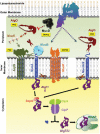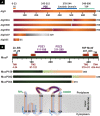Pseudomonas aeruginosa Regulated Intramembrane Proteolysis: Protease MucP Can Overcome Mutations in the AlgO Periplasmic Protease To Restore Alginate Production in Nonmucoid Revertants
- PMID: 29784885
- PMCID: PMC6060363
- DOI: 10.1128/JB.00215-18
Pseudomonas aeruginosa Regulated Intramembrane Proteolysis: Protease MucP Can Overcome Mutations in the AlgO Periplasmic Protease To Restore Alginate Production in Nonmucoid Revertants
Abstract
The progression of cystic fibrosis (CF) from an acute to a chronic disease is often associated with the conversion of the opportunistic pathogen Pseudomonas aeruginosa from a nonmucoid form to a mucoid form in the lung. This conversion involves the constitutive synthesis of the exopolysaccharide alginate, whose production is under the control of the AlgT/U sigma factor. This factor is regulated posttranslationally by an extremely unstable process and has been commonly attributed to mutations in the algT (algU) gene. By exploiting this unstable phenotype, we isolated 34 spontaneous nonmucoid variants arising from the mucoid strain PDO300, a PAO1 derivative containing the mucA22 allele commonly found in mucoid CF isolates. Complementation analysis using a minimal tiling path cosmid library revealed that most of these mutants mapped to two protease-encoding genes, algO, also known as prc or PA3257, and mucP Interestingly, our algO mutations were complemented by both mucP and algO, leading us to delete, clone, and overexpress mucP, algO, mucE, and mucD in both wild-type PAO1 and PDO300 backgrounds to better understand the regulation of this complex regulatory mechanism. Our findings suggest that the regulatory proteases follow two pathways for regulated intramembrane proteolysis (RIP), where both the AlgO/MucP pathway and MucE/AlgW pathway are required in the wild-type strain but where the AlgO/MucP pathway can bypass the MucE/AlgW pathway in mucoid strains with membrane-associated forms of MucA with shortened C termini, such as the MucA22 variant. This work gives us a better understanding of how alginate production is regulated in the clinically important mucoid variants of Pseudomonas aeruginosaIMPORTANCE Infection by the opportunistic pathogen Pseudomonas aeruginosa is the leading cause of morbidity and mortality seen in CF patients. Poor patient prognosis correlates with the genotypic and phenotypic change of the bacteria from a typical nonmucoid to a mucoid form in the CF lung, characterized by the overproduction of alginate. The expression of this exopolysaccharide is under the control an alternate sigma factor, AlgT/U, that is regulated posttranslationally by a series of proteases. A better understanding of this regulatory phenomenon will help in the development of therapies targeting alginate production, ultimately leading to an increase in the length and quality of life for those suffering from CF.
Keywords: AlgT/U; Prc/AlgO/Tsp; RseP/MucP/YaeL; anti-sigma factor; cystic fibrosis; mucoid conversion; sigma factors; sigma-22; sigma-E; σ22; σE.
Copyright © 2018 American Society for Microbiology.
Figures




Similar articles
-
Overproduction of the AlgT Sigma Factor Is Lethal to Mucoid Pseudomonas aeruginosa.J Bacteriol. 2020 Sep 23;202(20):e00445-20. doi: 10.1128/JB.00445-20. Print 2020 Sep 23. J Bacteriol. 2020. PMID: 32747430 Free PMC article.
-
A complex multilevel attack on Pseudomonas aeruginosa algT/U expression and algT/U activity results in the loss of alginate production.Gene. 2012 May 1;498(2):242-53. doi: 10.1016/j.gene.2011.11.005. Epub 2011 Nov 9. Gene. 2012. PMID: 22088575 Free PMC article.
-
Outer-membrane protein LptD (PA0595) plays a role in the regulation of alginate synthesis in Pseudomonas aeruginosa.J Med Microbiol. 2018 Aug;67(8):1139-1156. doi: 10.1099/jmm.0.000752. Epub 2018 Jun 20. J Med Microbiol. 2018. PMID: 29923820 Free PMC article.
-
Proteolytic regulation of alginate overproduction in Pseudomonas aeruginosa.Mol Microbiol. 2012 May;84(4):595-607. doi: 10.1111/j.1365-2958.2012.08049.x. Epub 2012 Apr 13. Mol Microbiol. 2012. PMID: 22497280 Free PMC article. Review.
-
The algD promoter: regulation of alginate production by Pseudomonas aeruginosa in cystic fibrosis.Cell Mol Biol Res. 1993;39(4):371-6. Cell Mol Biol Res. 1993. PMID: 8312973 Review.
Cited by
-
Effects of Sub-Minimum Inhibitory Concentrations of Gentamicin on Alginate Produced by Clinical Isolates of Pseudomonas aeruginosa.Adv Biomed Res. 2023 Apr 25;12:94. doi: 10.4103/abr.abr_389_21. eCollection 2023. Adv Biomed Res. 2023. PMID: 37288011 Free PMC article.
-
Bacterial Carboxyl-Terminal Processing Proteases Play Critical Roles in the Cell Envelope and Beyond.J Bacteriol. 2022 Apr 19;204(4):e0062821. doi: 10.1128/jb.00628-21. Epub 2022 Mar 16. J Bacteriol. 2022. PMID: 35293777 Free PMC article. Review.
-
Pseudomonas aeruginosa mucinous phenotypes and algUmucABD operon mutant characteristics obtained from inpatients with bronchiectasis and their correlation with acute aggravation.Front Cell Infect Microbiol. 2024 Jul 29;14:1402348. doi: 10.3389/fcimb.2024.1402348. eCollection 2024. Front Cell Infect Microbiol. 2024. PMID: 39135639 Free PMC article.
-
Overproduction of the AlgT Sigma Factor Is Lethal to Mucoid Pseudomonas aeruginosa.J Bacteriol. 2020 Sep 23;202(20):e00445-20. doi: 10.1128/JB.00445-20. Print 2020 Sep 23. J Bacteriol. 2020. PMID: 32747430 Free PMC article.
-
BosR: A novel biofilm-specific regulator in Pseudomonas aeruginosa.Front Microbiol. 2022 Oct 13;13:1021021. doi: 10.3389/fmicb.2022.1021021. eCollection 2022. Front Microbiol. 2022. PMID: 36312952 Free PMC article.
References
-
- Govan JR, Harris GS. 1986. Pseudomonas aeruginosa and cystic fibrosis: unusual bacterial adaptation and pathogenesis. Microbiol Sci 3:302–308. - PubMed
-
- Mathee K, Ciofu O, Sternberg C, Lindum PW, Campbell JI, Jensen P, Johnsen AH, Givskov M, Ohman DE, Molin S, Hoiby N, Kharazmi A. 1999. Mucoid conversion of Pseudomonas aeruginosa by hydrogen peroxide: a mechanism for virulence activation in the cystic fibrosis lung. Microbiology 145(Part 6):1349–1357. doi:10.1099/13500872-145-6-1349. - DOI - PubMed
Publication types
MeSH terms
Substances
Grants and funding
LinkOut - more resources
Full Text Sources
Other Literature Sources
Miscellaneous

